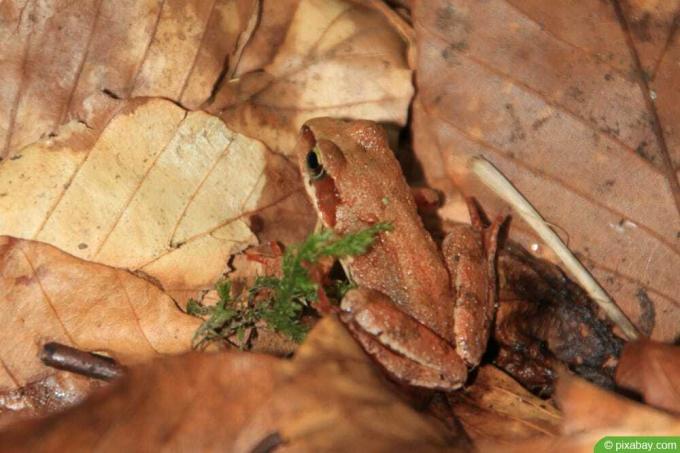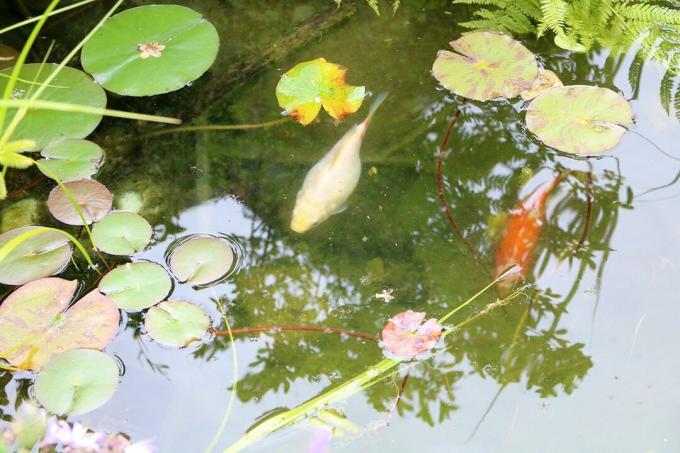

Table of contents
- recognize frogs
- Frog species and food preferences
- balance in the garden pond
What could be nicer than listening to the frogs' quack concert on a warm summer evening. Although amphibians can get quite noisy during mating season, they are important helpers in a garden. Frogs are hunters and will only go for live, moving prey. They snatch the prey with their tongues and swallow it whole.
recognize frogs
The frog never leaves wet areas because drought can be dangerous for them. If the living environment and the basic food are available, then even with a newly created pond, the croaking guests will not be long in coming. Characteristics of a frog:
- slender elongated body
- long slender legs
- webbed feet
- smooth to shiny skin
- bouncing locomotion
- Habitats in the area of water bodies
A notice:
The frog is occasionally confused with a toad. While they both have the same diet, toads only go into the water to spawn and spend the rest of the time on land.
Frog species and food preferences
Many are familiar with the tree frog and the common frog, but numerous other species find a home in the garden pond. They can live together without any problems, because although their main source of food is insects, most species have certain preferences.
A notice:
The coexistence between amphibians and fish usually runs without problems when it comes to native fish species. However, exotic fish such as koi can also be associated with different amphibians or whose offspring become dangerous.
tree frog(Hyla arborea):
- Approaching insects (mosquitoes, dragonflies)
- smaller insects (crickets, beetles)
- Spiders (all native species)

The food spectrum of the tree frog is very large. They are not very choosy and will eat a variety of arthropods if they don't catch insects in flight.
common frog(Rana temporaria):
- Insects (ground beetles, flies, mosquitoes, fruit flies)
- Spiders (all native species)
- Nudibranchs (generally all native snails, preferably aquatic species such as water slugs)
- Worms (predominantly annelids)

The common frog has a greater range of movement around wetlands. Likewise is its diet, which not only focuses on insects but also includes smaller slugs. This makes the common frog in the garden an important resident in the fight against snails.
A notice:
In the case of common frogs in the garden, slug pellets should definitely be avoided. If the amphibians eat a poisoned snail, it means inevitable death for them too.
Little Pond Frog(Rana lessonae):
- Approaching insects (flies, dragonflies, mosquitoes)
- Insects (locusts, crickets)
- smaller vertebrates (small lizards, other frog species)

The small pond frog has such a strong jaw that it can easily include smaller vertebrates in its diet.
marsh frog(Rana ridibunda):
- Insects (water beetles, ground beetles, dragonfly larvae)
- small invertebrates (annelids)
- Smaller fish (mainly young fish of exotic species such as goldfish or koi)
- smaller mice (careless young animals of all mouse species)

The marsh frog moves almost exclusively in the water or near the shore. As a result, when searching for food, it also focuses primarily on creatures in the water area. Problems can arise here if fish are kept in the pond.
water frog(Rana esculenta):
- Approaching insects (dragonflies, mosquitoes)
- Insects (ground beetles, grasshoppers)
- smaller vertebrates (lizards, small fish)

Compared to other frogs, the edible frog does not grab its prey with an outstretched tongue, but in a leap. However, he hunts exclusively in or at the water. If smaller vertebrates fall into the water, they too often fall victim to the edible frog.
balance in the garden pond
Small garden ponds in particular can become breeding grounds for mosquitoes in summer. Frogs are welcome helpers here. Some species not only eat the mosquitoes, they also eat the mosquito larvae. This also applies to other insects that live in or near the water. Unfortunately, some beautiful dragonflies fall victim to the frogs.
However, it is important for the frog that its food source can be found in the area of the pond. Otherwise no amphibians will settle in new plants or if the infrastructure is no longer suitable, the frog will migrate at some point. Natural garden ponds are preferred by the frogs, whereby natural does not mean overgrown. The frog needs retreats where it can hunt undisturbed. Since he also spends a lot of time on the water surface or spends on land, it is important to make the pond shore attractive for the amphibians.
Selection of plants for the pond shore:
- stream exercise (Veronica beccabunga)
- loosestrife (Lythrum salicaria)
- buckbean (Menyanthes trifoliata)
- lady's mantle (Alchemilla vulgaris)
- Creeping buttercup (Ranunculus repens)
- Siberian iris (Iris sibirica)
- marsh marigold (Caltha palustris)
- calamus (Acorus calamus)
- Cattails (Typha angustifolia)
Plants such as the marsh marigold, lady's mantle or buckbean offer the frogs different options. On the one hand, they can hide very well under it, on the other hand, they also use the large leaves to settle down and catch prey.
Tip:
Both free and overgrown shore zones offer frogs attractive habitats where they can hunt. Water and shore areas should be a balance of tall and low plants.
Overgrown wet zones that are supplemented with a few aquatic plants are ideal, but they should not cover the entire pond. Too many plants can cause the pond to tip over, which also deprives the amphibians of their food sources.
Suitable aquatic plants:
- frog bite (Hydrocharis morsus ranae)
- water lilies (all types suitable)
- Streaky pondweed (Potamogeton perfoliatus)
- water whisk (Hydrilla verticillata)
The choice of plants and how many are planted depends on the size of the pond. In principle, every body of water is attractive for a frog species - even a few square meters of water attract the amphibians. However, frogs such as the pond frog defend their feeding grounds, which means that the smaller the garden pond, the fewer amphibians settle there.
 garden editorial
garden editorial I write about everything that interests me in my garden.
Find out more about animals in the garden pond

22 small pond fish | Fish for small pond
Only a small pond fits in small gardens. But Mother Nature has also created a few little fish for these mini ponds. To be more precise, even several interesting species, which are not inferior in beauty to the large specimens. But be amazed!

7 Fish Diseases | Help for pond fish
For many an animal lover, their fish mean everything. The concern is correspondingly great when the animals suddenly behave in a strange way or show external symptoms of one of the numerous pond fish diseases. This guide explains how the owner makes an exact diagnosis, what causes it and what to do in this case.

Overwintering pond mussels | 14 tips for pond mussels in winter
Pond mussels are practical animals for the garden pond, as they can filter and thus clean the water. Their main food source is algae. But what happens to the pond mussel in winter when the water surface freezes over? Here we reveal how overwintering is possible.

Orfe in the garden pond | 10 tips for keeping & propagation
The water has been filled in, the green planting is in place. Now a color contrast and movement in the garden pond are still missing. A swarm of gold orfs can provide both. Yellow-orange in colour, they are clearly circling in the water. When do you feel comfortable in it?

Sturgeon in the garden pond | 10 tips for keeping in the pond
Would you like to enrich your pond with a real sturgeon? The desire for such a striking animal is easy to understand. Our tips on how to handle this living fossil will help you ensure that keeping is always successful.

Sterlet - keeping in the garden pond | Information on growth & feed
The sturgeon is considered to be one of the oldest fish species. This is precisely why it has an almost magical attraction for numerous pond owners. But if you want to settle the sterlet as the most common representative of these living fossils in your own waters, you should consider a few things.
